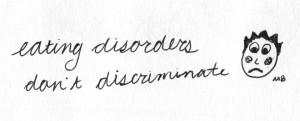Why men should be included in the eating disorder dialogue
Eating disorders like bulimia and anorexia plague many women from puberty through adulthood. According to the National Eating Disorders Association (NEDA), there are 20 million documented cases of women with some type of eating disorder — about six percent of all women in the United States. This percentage grows even larger among students, with 50 percent of women using unhealthy methods to control their weight.
However, while girls with eating disorders are a frequently discussed topic, boys with eating disorders are often left by the wayside. According to Eating Disorder Hope, about 1 million men suffer daily from clinical eating disorders across the United States, whether it be anorexia, bulimia or binge-eating. But unfortunately, the media often fails to normalize the idea that men can suffer from body image issues, too.
Enter Zayn Malik, former One Direction vocalist and now solo artist.
Malik is known for being not only a powerhouse singer, but also a teenage heartthrob. However, despite his success and popularity, Malik has recently come out about his struggle with anorexia via his autobiography Zayn.“Something I’ve never talked about in public before, but which I have come to terms with since leaving the band, is that I was suffering from an eating disorder,” Malik wrote. “I’d just go for days — sometimes two or three days straight — without eating anything at all. It got quite serious, although at the time I didn’t recognize it for what it was.”
Malik reflects in his book on how ill he became as a result, with his anorexia reaching an all time peak in November of 2014. Since dropping out of One Direction and becoming a solo artist, Malik has been able to start eating regularly again. According to his book, this correlates largely with the fact that Malik restricted his eating in order to have control over something; it can be insinuated that as a member of a boy band, he felt fairly micromanaged in every other area of his life.
Writing for GQ, Nathaniel Penn chronicled the lives of men like Malik who struggle with eating disorders in one form or another. They all cited different reasons: relationship troubles, self-esteem issues, depression, a need for control (a la Malik). But there was one startling thing in common: almost none of them received help and one even died from their disorder.
“Twenty percent and rising. More and more men are starving themselves to death in a pathological pursuit of perfection,” Penn said. “Male anorexics have much in common with women who suffer from the same debilitating illness, but there’s a striking difference: For the vast majority of men, help is not on the way.”
According to the National Eating Disorder Association (NEDA), while eating disorders are more common among women, men have a higher mortality rate. They also are more likely to have comorbid conditions, like excessive exercise and substance abuse. So why is talking about male eating disorders in the media so stigmatized?
The main reason for this stigma is the notorious enforcement of gender stereotypes. Concerns such as one’s appearance and low self-esteem are often classified as “woman problems.” As early as 1689, researcher Richard Morton studied two cases of anorexia: a man and a woman. However, when eating disorder research became popular centuries later in the 1970s, 99 percent of books about eating disorders developed a bias for women.
If even researchers ignore the signs of eating disorders in men, then how is the media supposed to pick up the slack, especially when they are the main source for how a man is supposed to look? NEDA reports that 68 percent of college-aged males feel “they have too little muscle.” It’s well-known that unrealistic body expectations in the media correlate with the high number of female eating disorders, so it should be natural to grant males this same correlation.
As a celebrity, Zayn Malik is someone who helps set the media’s standards for what a male should look like, yet even he is affected by these standards. If a pop culture trend setter, someone that teens look up to as a source of fashion and body inspiration, cannot cope with the pressure to be perfect all the time, then what does that say for all of the young men out there who don’t have million dollar record deals?
For the men interviewed in Penn’s GQ feature, it means frequent hospital visits, lying about their issues to their family, ruined relationships and worse. But because male eating disorders are so rarely talked about in both research and the media, doctors don’t think to diagnose them even if a patient has all the signs.
“Certainly twenty years of lean, muscular male physiques in advertising, movies, sports, and of course, magazines like GQ — from Marky Mark to Brad Pitt to David Beckham — have changed the way both men and women regard the male body,” Penn said.
This chiseled masculinity that is insidious through film, TV, magazines and music shows young boys what it looks like to be a man. Teenage boys who put on extra weight during puberty see this as wrong and unnatural just like girls do. Eating disorders know no gender, but the media only focuses on what it’s like to be a girl and affected. As a result, boys with eating disorders think they’re anomalies even though they’re not, feel ashamed and don’t seek help. It’s a vicious cycle: men don’t report eating disorders because they’re not represented in the media, but the media doesn’t represent male eating disorders because men don’t talk about it.
Alex Coburn is a first-year cinema photography major who doesn’t buy into gender-specific troubles. You can contact them at acoburn@ithaca.edu.

